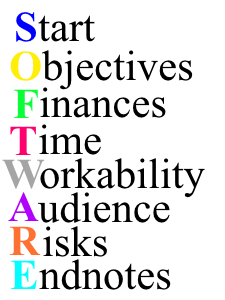In order to address the growing demand of companies to be able to choose an ERP (enterprise resource planning) system among multiple available options to suit the corporate needs fully and within their industry and operational standards, Edocation has developed the SOFTWARE model.
The central notion of this model is the “context” the importance of which has been explored in linguistics, including through D. Hymes’s (1974) SPEAKING model (BLOG|ON|LINGUISTICS, 2019). The SOFTWARE model enables companies to analyze ERP (and other) programs, not only within the narrow software context, but within the wide industry-specific and operational contexts of a given company. Moreover, the model can be repeatedly applied to different programs to obtain comparable (“apples to apples”) results, which, in turn, can help select a new ERP, BI (business intelligence), Dynamics 365 (includes CRM – customer relationship management) and other software that meet the corporate goals fully.
To learn more about D365BC, including its financial reporting, budgeting and inventory capabilities, the industries and sectors it serves, its license types and their prices; to familiarize with the implementation process and estimate implementation cost, visit the corresponding page or hire a consultant.
S = START – the general, brief notes about the ERP system under analysis:
– is it intended for small or large enterprises;
– what are the available modules (GL, Cash/Bank, AP, AR, inventory, fixed assets and so on);
– what is the biggest selling point of the system (easy to integrate with, scalable, flexible reporting), etc.
O = OBJECTIVES – the key goals of the company seeking to implement an ERP system:
– to improve financial reporting;
– to increase the accuracy of inventory management;
– to be able to integrate with other systems, etc.
F = FINANCES – how much does it cost to implement the system, to maintain and, importantly, to upgrade it:
– how much is hourly rate of the people doing the implementation;
– how much is the monthly cost of a user’s license;
– what does it cost to upgrade the system in the future, etc.
T = TIME – how long does it take to get the system up and running:
– the implementation time;
– what is the wait time to receive support after Go-Live;
– how time consuming is it to to upgrade to a newer version;
– how long does it take to train users, etc.
W = WORKABILITY – how easy it is to work in the system:
– how easy is it to perform day-to-day business duties such as entering a sales invoice, issuing a credit memo, creating a new vendor, adding a new item and so on, based on the key business needs;
– how easy it is to create basic BS, IS, and TB reports;
– how efficiently it is to run inventory routine;
– how practical is the year end procedures, etc.
A = AUDIENCE – who are the people that will be doing the implementation (and then support) and who are the team that will be using the system:
– taking into consideration the current human resources that a company disposes of, is it enough to implement and, importantly, to maintain the system;
– will this ERP system help the managers to run their business reports while improving other people’s efficiencies too;
– is the team open to learning the new technology on top of their day-to-day business duties;
– can the new software increase the efficiency of work with the clients and vendors of the company, etc.
R = RISKS – the challenges that may arise in implementing and maintaining the system and how to address them:
– how much can the implementation be beyond the budget, will the implementer put a cap on the overage and deliver the rest of the scope at a reduced or no additional cost;
– how flexible is the system to accommodate unforeseen or new requirements – what are the mechanisms to address them (e.g. development, enabling a new module, inviting an additional implementer’s subject matter expert who has experience with that module and so on);
– how easy it is to change the ERP provider, etc.
E = ENDNOTES – the general, brief, concluding remarks about the ERP system under analysis:
– is it a good fit for the organization at first glance;
– is it affordable for the company;
– is it able to grow with the organization or will it have to be replaced in the nearest future, etc.
Each of the above points can be quantified to make the analysis of multiple software options even more accurate. For example, if there are 3 options available (software A, software B, software C), each of them needs to be assessed with respect to START and other points on a scale of 1 to 3 (or 1 to as many as there are programs assessed). The software that scores highest overall may be the best option to choose. Moreover, in some cases, some analysis points can be omitted for greater flexibility (e.g. ENDNOTES can be omitted if this point is irrelevant to a particular analysis).
To sum up, this post has discussed the SOFTWARE model that can help companies compare and choose ERP and other software that fits their key business needs. The central notion of this framework is the context. Besides ERP systems, this model can also be used for the analysis of BI systems and other software.
At Edocation, our goal is to help companies make an informed decision about their next ERP system. If you would like to discuss your ERP needs with one of our certified specialists, contact us for a free no obligation consultation.
1. Microsoft Dynamics 365 Business Central (D365BC) License Calculator
2. What is Microsoft Dynamics 365?
3. What is Microsoft Power Platform?
References
BLOG|ON|LINGUISTICS (2019). Retrieved December 11, 2019, from https://blogonlinguistics.wordpress.com/2013/09/07/speaking-model-d-hymes/
Hymes, D. (1974). Foundations of sociolinguistics: An ethnographic approach. Philadelphia: University of Pennsylvania Press.

